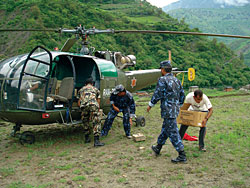 NEPAL ARMY |
On 29 June, Bhim Bahadur Shahi was home in bed in Punma village wracked by diarrhoea. The nearby health post had no doctors or nurses, and no medicines. A neighbour named Tikhu, himself suffering from the disease, volunteered to carry 23-year-old Shahi to the nearest health clinic in Syaulibajar, three hours away.
After struggling for one hour up the trail, Tikhu stopped for a rest, and died of exhaustion. Half-an-hour later, Bhim died too.
Three months ago, when politicians in Kathmandu were pre-occupied with the resignation of the Maoists and the formation of a new coalition, people were already starting to die of gastric infections in Nepal's mid-western hills. The deaths weren't taken very seriously because people here are used to an annual spike in diarrhoea-related deaths before the monsoons. But because a severe winter drought and a late monsoon had dried up all water sources, people were forced to drink contaminated water.
In remote Nepal where health services, even where they exist, are rudimentary the best way to tackle diarrhoea and cholera is through prevention. In a roadless district with low literacy, the epidemic spread like a brushfire.
Eight-year-old Dilsara Nepali's house in Thana Suwanauli is three minutes away from the local sub-health post. On 30 June she died after struggling with severe diarrhoeal dehydration. Dilsara's mother is distraught. "There was no one at the health post so we had to take her to Thala," she said, "but she left us on the way there."
There are many causes for this year's killer epidemic, and they start with decades of government neglect that has kept the mid-western hills the country's least-developed. Then there was the war, and the six districts of the mid-west were in the vortex of the conflict: health posts were abandoned, village councils were bombed, doctors and health workers refused to go to remote areas.
The present government failed to react fast enough. Two months into the epidemic the government hadn't yet revived local health posts let alone sent medicines and health personnel. The health assistants were on leave.
Social worker Dil Bahadur Shahi at Phalaha says: "Those who could afford to buy medicines at private clinics survived, most others perished. Karbir Chunara of the District Network of Dalits says the lack of education and safe drinking water has affected his community the most. Among the 141 people who have died in Jajarkot, 64 are Dalit and 24 are Janajati. Among those currently ill and receiving treatment, 60 per cent are Dalit.
Now, there is the added challenge of taking care of the children orphaned by the epidemic. Bhim left behind an 18-year-old wife and one-year-old son, and Tikhu had four children, whose future now looks bleak. Tikhu's wife, Jayanta Shahi, says: "My husband used to work in India and sent money home, and that is how we survived. Now I don't know what to do."
On 20 July Prime Minister Madhav Kumar Nepal visited Jajarkot and announced up to Rs 15,000 for families of cholera victims, and the Health Minister said they would get 10 kg of rice and 1 kg of salt. No one has got anything yet. Man Bahadur Buda in Lewa says: "There was an announcement on the radio that we would get help soon, but we've seen neither doctors nor medicines."
In recent weeks, the army has also mobilized its air wing. The people of Jajarkot used to flee when they heard army helicopters during the war, this time they rush out as the green choppers crisscross the district rushing medicine and doctors.
READ ALSO:
Rajeev goes to Jajarkot - FROM ISSUE #464 (07 AUG 2009 - 20 AUG 2009)
Beating malnutirion - FROM ISSUE #464 (07 AUG 2009 - 20 AUG 2009)


